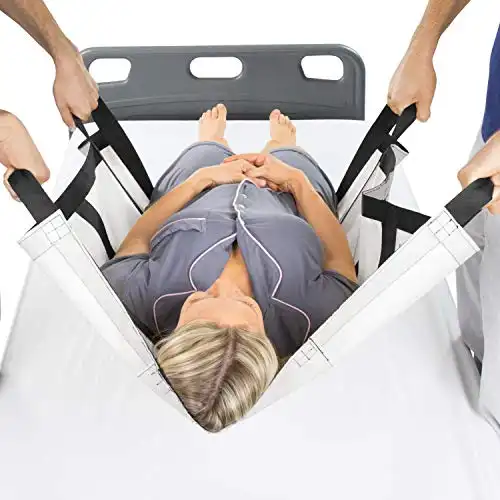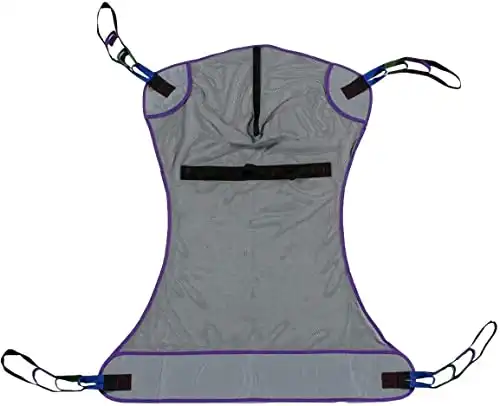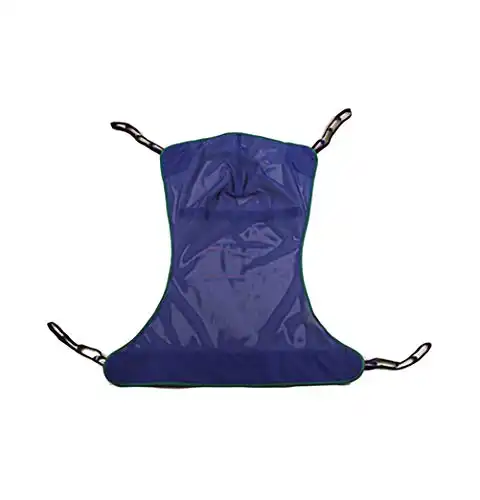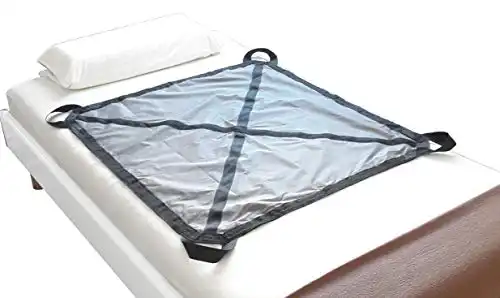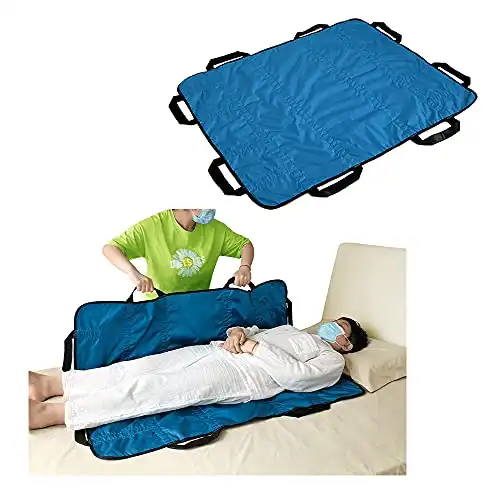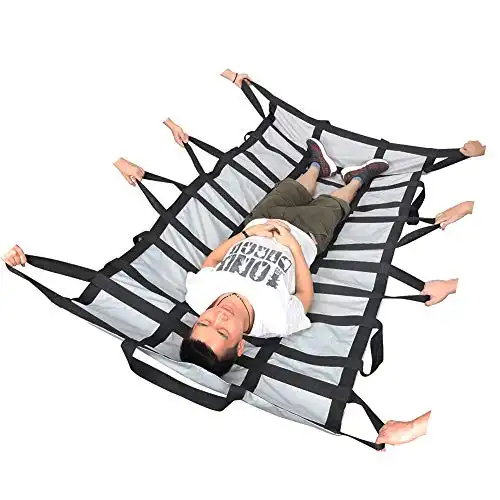If you have ever been a caregiver to an elderly patient who is bedridden and has partially or completely lost mobility, you would know the importance of moving or turning them and changing their position as often as possible.
In this article, we will discuss the importance of turning patients regularly, the advantages of using a turning device, and the considerations to keep in mind when buying a turning device. Finally, we will look at some of the best available turning devices in the market.
The unfortunate truth is that once you become immobile you are more likely to put on weight more quickly. This fat deposition happens significantly at the sub cutaneous layer or just under your skin.
Therefore, disabled or immobile patients are more prone to bedsores, skin ulcers, or skin tears due to this excess fat developing too quickly and a lot of body weight consistently pressurizing the skin at the points or areas of sustained pressure.
This can only be avoided if you keep moving your and keep changing their position, so that no specific part of the body bears the weight for too long. For individuals who can move around, this is less of a problem and they should be encouraged to be mobile within a certain limit.
In this article, we review some of the devices and apparatus for turning a patient in bed. The table below gives a quick snapshot of our top selections, and you can scroll down for detailed reviews of the products.
|
Type:
Sheet
|
Type:
Sling
|
Type:
Sling
|
Type:
Sheet
|
Type:
Sheet
|
Type:
Sheet
|
|
Weight Capacity:
300 pounds
|
Weight Capacity:
600 pounds (XXL)
|
Weight Capacity:
600 pounds (XXL)
|
Weight Capacity:
250 pounds
|
Weight Capacity:
250 pounds
|
Weight Capacity:
600 pounds
|
|
Size:
Small, Large
|
Size:
Medium, Large, XXL
|
Size:
Medium, Large, XL, XXL (Mesh and Soild Options)
|
Size:
One size (42" X 36")
|
Size:
One size (48" X 40")
|
Size:
One size (81" X 40")
|
Contents
Importance of Moving or Turning Patients
Even if movement or change in position of the patient is small, it can lend significant and immediate comfort to the tissue that was under stress. Small movements may include turning the patient 10 degrees on the side or straightening the bed from an angle of 15 degrees to 75 degrees to relieve stress off the back.
These periodic movements are enough to prevent lack of blood flow to certain tissue or reducing continued friction of certain tissue and the bed surface, or just relieving sustained pressure off skin tissue which is weak or is under a bone.
Inspecting Bedridden Patients for Skin Damage
For caregivers, it is especially important that you regularly inspect bedridden patients for skin damage. It is especially true for a disabled patient with partial or complete paralysis. For these patients, it is not possible for them to feel a skin tear or abrasion, so they may not be able to alert you of discomfort. Or, by the time they can alert you, it may be too late and skin ulcer would have set in.
You should look out for telltale signs of skin damage – red patches, areas of skin where temperature is warm, and areas that are pale in color due to continued lack of blood flow. If you find one, immediately consult a physician and take care not to have the patient sleep or sit in a position which might further aggravate their condition.

How Often Should You Turn a Patient in Bed?
Ideally, you should change the patient’s position once every hour. However, depending on body weight and disability of the patient, this can stretch to once every two hours, but not more than that. Even able-bodied individuals will not feel comfortable sleeping in the same position for much more than a couple of hours. If there is an existing skin tear or ulcer, take care to avoid a position that puts pressure on the affected area.
Additionally, if the patient has some mobility, you can instruct them to make subtle changes in positions every now and then or whenever they feels the need to. Also, you should always document at least the last 5 positions and the location of any suspected skin damage for your own records if you are the only caregiver of the patient.
Correctly documenting positions is all the more important if there are multiple caregivers for a patient so that to maintain a correct and streamlined flow of information across caregiver shifts.
The video below provides a demonstration of how to turn a patient in bed.
Why Might You Want a Patient Turning Device?
For completely immobile or , caregivers or nurses will need to do every two hours, after an incontinence episode, or if the is complaining of a skin sore in a specific position.
Given that weights range between 150 to 400 pounds, if the is on the heavier side, it can be inconvenient and even dangerous to manually turn or lift them, even for two caregivers together.
If you have arranged for a 24/7 personal at home, it will often be a single person doing the caretaking and so it can be even more inconvenient for both the and the or .
Over a period of doing this manually, caregivers can run the risk of developing back injury or strain. Improper movement can also be detrimental to the health and recovery of the .
Therefore, it is for the best interest of both and that you invest in a . The device eliminates the need of a second helper to do safe and most caregivers would already be trained to use one.
There is specialized equipment that is available for helping you turn a in . These can be known as a transfer blanket, a hoist sling, a or , or a , all of which are essentially blankets or sheets with handles that enable the or to get a hold on the blanket and turn the on the .
You may also like How to Bathe an Elderly Person in Bed?
What to Consider Before Buying a Patient Turning Device
- Weight of the patient: If you are planning to invest in a patient turning device for a plus size patient, it is important that you should consider the maximum carrying capacity of the device. While most transfer blankets can carry weights over 300 pounds, some lightweight cost effective solutions exist with a maximum capacity of 200-250 pounds.
- Durability & comfort: For longevity of the product, it should be made of a durable material with reinforced handles. Turning devices often break and tear at the handles, so you may want to inspect the handles. Also, if the blanket has a thin layer of foam, it can add to the comfort of the patient and reduces the risk of skin ulcers and bedsores.
- Number of handles: If it is always going to be the case that only one caregiver is going to work with your patient, just four handles would suffice on the turning device. However, if you are dealing with a heavier patient and would time to time require the help of a second helper, it is best that you buy a device with more than 4 handles, preferably 6 – 8.
- Maintenance: It is especially important that the device is easy to clean and maintain. The ideal approach is to be able to machine wash it (take care not to wash in hot water, cold or warm water is fine) and it should be dryer friendly.
- Waterproofing: This is a desirable characteristic for these bed turners and most of them are likely to have it.
Apparatus for Turning a Patient in Bed
We have reviewed a few of the most recommended turning devices available in the market, with the expectation that these reviews will help you in arriving at your buying decision.
The patient turning devices available in the market are largely of 2 types – sheet (blanket) and sling. Sheet type devices are specifically meant for turning purpose. Sling type devices can also be used for carrying a patient in a lift.
#1 – Vive Transfer Blanket with Handles
The Vive transfer blanket is made with lightweight nylon material that is anti-slip. The device has four padded handles attached to the blanket with reinforced stitching for longer life. There are four horizontal and two vertical nylon reinforcements on the blanket for added strength.

Pros
- Available in 2 sizes: small (supports up to 300 lbs) and large (supports up to 600 lbs)
- Machine washable and dryer friendly
- Reinforced nylon handles / loops for more longevity
- Padded grips for more comfortable grips
- One year guarantee indicates the better quality of the product and manufacturer confidence
Cons
- Intermediate nylon reinforcements may cause discomfort and leave marks on the patient’s skin
- Insufficient padding for long period of use
You may also like Bedroom Aids for the Elderly
#2 – Patient Lift Sling by Patient Aid
The product is made of 3 layers – the uppermost polyester layer that is waterproof, the absorbent layer in the middle, and the third polyurethane layer for better protection. It has four handles with reinforced stitching material for added strength and longevity.

Pros
- Waterproof and can be used in cases of incontinence
- Available in five sizes, to be selected as per patient requirement
- Machine washable in cold or warm water and can be machine dried under low heat
- Cost effective solution for turning and repositioning patients on bed
Cons
- For larger versions, the two handles may be inconvenient for a smaller caregiver
You may also like our article about transport wheelchairs for patients with an atttendant
#3 – Invacare Reliant Full Body Sling for Turning Patient
This is a multipurpose device that can be used for repositioning and turning the patient in bed or as a sling lift for transporting immobile patients. The device is made of polyester and the dimensions of the largest version (XXL), meant to carry weights up to 600 lbs, are 55 (L) x 45 (W) inches. There are four handles with reinforced stitching.

Pros
- Available in four sizes – from carrying capacities of 150 lbs up to 600 lbs
- Machine washable on mild detergent and can be dried on low heat
- Non-slip strip at the end of the device prevents patients from sliding
- 1 year limited warranty, but keep an eye on shipping policies on warranty invocation
Cons
- For very heavy patients, if more than one caregiver is required, gripping the turner will be a problem, as there are only two handles on each side
You may also like Equipment to Help You Get Out of Bed
#4 – Heavy Duty Patient Positioning Sheet by Opatek
This transfer blanket is made with dual layer lightweight nylon with the lower layer reducing friction for easy turning and repositioning. It has a maximum carrying capacity of 250 lbs. The dimensions of the product are 42 x 36 inches and is sufficient to lift most adult patients.

Pros
- Has four handles and can be used by a single caregiver
- Comes with a bag of its own, can be stored and put away when not using it
- Machine washable and can be easily dried in the dryer
- Cost efficient and durable solution
Cons
- Not meant to be used for heavy users
#5 – Patient Transfer Board Lift Sheet Device by NEPPT
This bed turner is made of double sided polyester fiber sheets and is reinforced on the back with four horizontal nylon strips. The product measures 48 (L) x 40 (W) inches with maximum carrying capacity of 250 lbs. It can be used as a sling lift as well.

Pros
- 8 reinforced handles, 2 on each side offers more comfort while repositioning patients
- Durable and waterproof
- Can be machine washed and dried and reused within a couple of hours
- The nylon reinforcements are on the back side, avoiding discomfort of contact with nylon
- Cost effective solution
Cons
- After washing several times, the polyester fiber may shrink and feel wrinkly on the back.
- Patient may slip down the polyester fiber sheets if the bed is too long
You may also like Best Diapers For Bedridden Patients
#6 – Patient Transfer Blanket with Handles by Fushida
This is a lifting and repositioning blanket with 12 handles and suitable for repositioning very heavy patients. It can be especially helpful for patients who require two people to turn or adjust . The transfer blanket is built with light nylon fabric and ten horizontal and two vertical nylon reinforcements to make it durable. Total dimension is 81 (L) x 40 (W) inches.

Pros
- Supports up to 600 lbs and large dimensions make it suitable for heavy patients
- Sturdy handles with reinforced stitching
- Made of softer material for added comfort
- Comes in a zipper bag for convenience in carrying the turning blanket
Cons
- The nylon reinforcements in the middle of the blanket may cause discomfort and leave marks on the skin
#7 – Transfer Board Bed Assistance Device by NEPPT
This is a repositioning device meant for relatively lightweight users with its maximum carrying capacity of 220 lbs. (100 kilograms). It is made of strong polyester material and a three layer structure with thick padding in between polyester layers.

The device has six handles, three on each side, and the blanket is reinforced on the bottom with six horizontal nylon strips. The dimensions of the product are 42.5 x 28 inches. This product is only for transferring or adjusting , as it is not waterproof and is not effective in cases of incontinence.
Pros
- Padded handles allow for more ease of use and comfort for caregiver while turning patient
- Durable fabric and reinforcements make it strong
- Added padding for extra comfort for the patient
Cons
- Width may be a bit on the lower side for some patients
- This product is not waterproof and cannot be washed; only the cover can be wiped
You may also like Best Pillow For Bedridden Patients
#8 – U-Turner by Ergomatrix Inc
The U-Turner is made up of ergonomic nylon, which reduces friction and prevents mildew deposition. The straps that have to be fit to the side railing of the bed to turn the patient are adjustable and therefore can fit a wide range of beds.

The product is available in different sizes – including a pediatric size (supports less than 120 lbs) and a bariatric patient size (which supports weights greater than 300 lbs).
Pros
- Single caregiver is sufficient to turn patient with the help of this device
- A made-in-USA product
- Machine washable and dryer friendly; Easy to maintain
- Product is available is customizable sizes (pediatric and bariatric patient sizes)
Cons
- Different mechanism than standard turning blankets; makes it difficult to handle at first
- Priced aggressively as device does not have multiple use (for example, it cannot be used with a ceiling lift)
- Fabric edges may be too sharp and can cause skin abrasion to the patient or caregiver
#9 – Vive Patient Lift Sling / Transfer Blanket
This device can act both as a lift sling and as a device for repositioning patients on the bed. It can be operated by a single person.
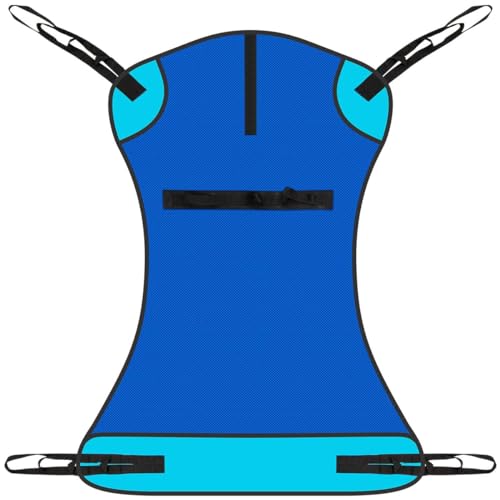
This is a one size fits all product, made of mesh fabric, with added padding under the leg, and a maximum weight bearing capacity of up to 700 lbs.
Pros
- Corners and handle joints are reinforced for better longevity
- Additional handles on the back side of the turner, makes it easier to reposition patients
- High maximum weight bearing capacity; suitable for heavy users
Cons
- May not be very comfortable for long use as it is made of mesh material
You may also like Best Adjustable Beds for Elderly
Vendlet V5S System
Finally, we would like to talk a bit about the Vendlet V5S system, which is a powered patient turning system and allows only one caregiver to accomplish the task easily with minimal effort.
It has a remote control that lets you automatically raise both sides of the bed and effects the turning of the patient by simultaneously releasing bed sheet from one side and rolling it back on the other side, thereby producing a rolling force which automatically makes the patient roll to one side.
The Vendlet V5S can handle patients with body weight up to 200 kgs or 440 pounds. The Vendlet V5S+ is a heavier duty version that can handle weights up to 400 kgs or 880 pounds.
However, this is an expensive equipment and may difficult to purchase for some patients who live on a fixed modest income.
The video below shows how the Vendlet V5 system works.
Parting Words – A Frequent Task Made Safer
As a caregiver, it is important that you use the right apparatus for turning a patient in bed. The convenience that a patient turning device provides you with can be immense when compared to its cost.
If you are planning to hire a caregiver for your immobile family member, you should note that the device helps to restore the dignity of the patient to a large extent and makes it a lot easier for both the patient and caregiver to go about their daily activities.
Our favourite product is the Vive Transfer Blanket with Handles, which has padded grips for enhanced comfort and comes in two sizes that both support a significant amount of weight.
For a value-for-money option, you can consider the Patient Lift Sling by Patient Aid, which is waterproof and comes in a whopping five different sizes to suit different requirements.
Similar to turning devices, you can make use of stand assist devices to help a patient stand up, or car transfer assistive devices to help transfer in and out of a car. Some elderly might want to use transfer discs to move from a wheelchair to a bed or vice versa.
One important product to invest in for bedridden patients is incontinence pads . These pads help protect the and the mattress in case of an incontinence accident.
Lastly, as a or an elderly person recovers from a procedure or stops being bedridden for long periods of time, they can do well with some simple but important assistive devices at home that will make their lives more independent .

